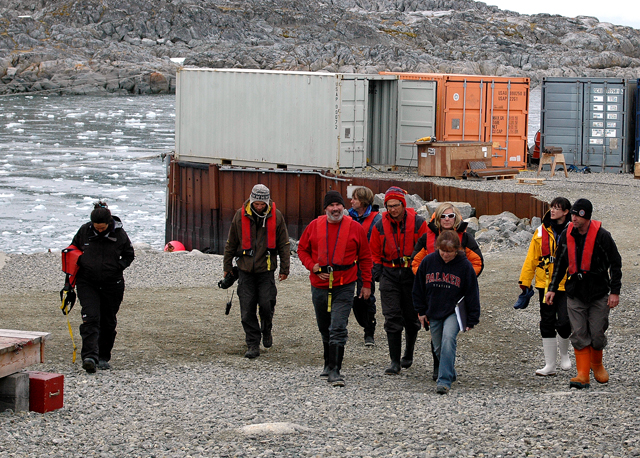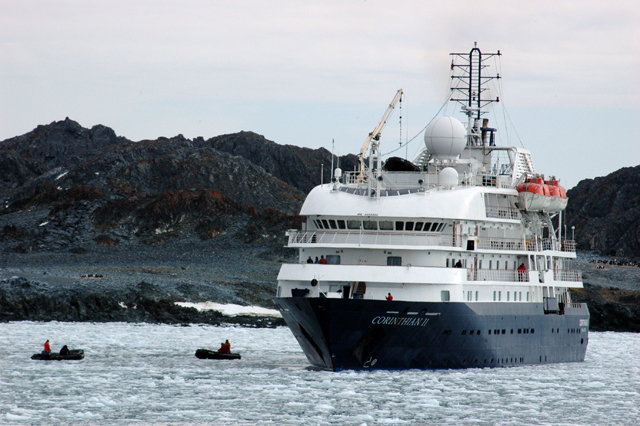Page 2/2 - Posted February 12, 2010
Dianne Smith, the administrative coordinator for the station, probably interacts the most with the tourists. She runs the store and is the point person for the small groups that arrive on the private yachts and sailboats. In one week, she may greet a group of tall Europeans from the Czech Republic or a small French family on a four-year sailing trip around the world. “It’s really interesting. It’s one-on-one, with all of these people throughout the world,” she says. “They all have lives and stories and families they share with you.” The large cruise ships — carrying hundreds, if not thousands of passengers — are too big to unload passengers here. Instead, station personnel go to them, zipping out to the cruise liners on Zodiacs. Brack says those ships, where Antarctica is more like a movie just going by the porthole, is where he meets the most excited visitors. “We’re rock stars. They can’t believe we’re real Antarcticans. We pull up out of the fog on Zodiacs. They can’t see station, and so here we come out of the haze, with our bright orange coats, and we’re Shackleton’s kin,” he says. Adds Station Manager Rebecca Shoop, “That’s really a big part of our outreach. We can hit a lot of people with the large cruise ships.” 
Photo Credit: Peter Rejcek
Dianne Smith guides a group from the Spirit of Sydney around Palmer Station.
Aboard those floating cities, station personnel present a 30-minute slideshow to passengers, followed by a Q&A on science and society in the Antarctic. Bright-eyed passengers aren’t shy about mingling after the presentation, thirsty for details about a place that only an hour before was just another abstract stop on their itinerary. Shoop says tourism outreach at Palmer has evolved over the last 20 years, as the NSF recognized both the value of bringing awareness of the Antarctic program to visitors, especially U.S. taxpayers, and ensuring that it doesn’t disrupt the station’s primary mission to support science. “They know we spend a lot of time doing outreach,” Shoop says. “We need to keep our structure intact — do the outreach but not bend over backwards to accommodate it. It sometimes gets a little tricky.” In addition, the National Geographic ship often carries scientists with the Oceanites Inc., a group led by Ron Naveen and funded by the NSF for seabird census work. The Spirit of Sydney, an expedition yacht that regularly cruises to Palmer Station, has supported whale research in the past and collaborated with station personnel on sending science samples back to the United States, according to Shoop. The International Association of Antarctic Tour Operators (IAATO) However, the worldwide recession may be taking a toll. In 2008-09, IAATO reported a total of 37,858 tourists, down significantly from the year before at 46,069. The numbers at Palmer Station from IAATO similarly declined — 1,016 last year and 1,304 the year before. Those numbers don’t reflect all of the smaller vessels or the offshore visits by station personnel to the larger cruise ships. Tough economic times may not be the only obstacle that slows down tourism here. In the last year, during a highly publicized meeting of the Antarctic Treaty countries that manage the continent, policy makers called for limits on the number of tourist ships, for fortified hulls that can withstand sea ice and for a ban on the use of heavy fuel oils. A ban on heavy oil, which is expected to be adopted by the International Maritime Organization Despite the uncertainty ahead for tourism in Antarctica, Palmer Station personnel expect they’ll still need to bake plenty of those yummy brownies each summer season. That’s OK with Jon Brack. “It feels good to have people thank you for what you do,” he says.Back 1 2 |



For USAP Participants |
For The Public |
For Researchers and EducatorsContact UsU.S. National Science FoundationOffice of Polar Programs Geosciences Directorate 2415 Eisenhower Avenue, Suite W7100 Alexandria, VA 22314 Sign up for the NSF Office of Polar Programs newsletter and events. Feedback Form |



